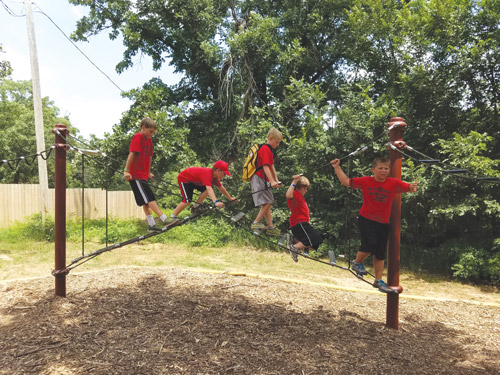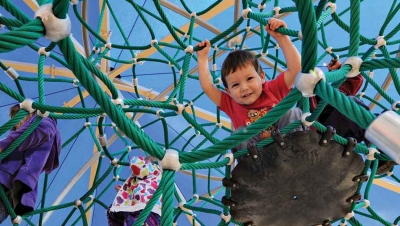Google “inclusive play” or “inclusive playgrounds” and you will find pages of entries – what it is, where you can find such playgrounds, who offers “inclusive playground equipment” and more.
Delve into this more and you will also find that many traditional inclusive playgrounds primarily focus on children with physical disabilities, failing to include those without physical disabilities or those without disabilities at all.
This raises the question: what kind of inclusion experience is it if it is neglecting over 90% of children who don’t have any disabilities at all to play?
There are many kinds of playground equipment that provide an “inclusive” experience; however, rope play equipment, net climbers, offer something for everyone, providing a more unique and ever-challenging experience for all abilities.
So, What is Inclusive Play?
In general, inclusive play bridges the gap between mainstream and children with special needs. Inclusive play enables children to better relate to one another, whether they have a special need or not, opening their eyes to the world around them.
Inclusive play enables better social integration. Learning about each other’s differences at a younger age can help children feel comfortable around those who are different.
Many children happily play together without noticing any differences. Encouraging children of all abilities to play together teaches them to treat each other the same.
Accessible or Inclusive Playground – What’s the Difference?
A 100% accessible playground goes beyond ADA Compliance, enabling everyone to get to and move all around the playground. Children in wheelchairs could, for instance, reach the highest point of a structure through ramps.
On the other hand, an inclusive playground accounts for human diversity in the community. That means, it offers barrier-free attractions while at the same time providing challenging and fun experiences for a wide variety of children – those without any disabilities along with those with ADHD, Down’s syndrome, sensory processing, visual or hearing impairments and other physical and developmental issues.
An inclusive playground offers a balance of play experiences for all abilities, achieving parallel play as much as possible. It enables children to embrace and experience their commonalities and differences as autonomously as possible and in close proximity to one another.
It is not about “leveling down” the experience nor is it necessary to remove every sandbox so that a child with little mobility does not notice that he or she cannot run.
Inclusive play and accessible play are often lumped together when accessibility is only a small part of what makes a playground inclusive. The ramps alone are merely an accessibility device and do not by themselves lead to engagement with other children. On the other hand, rope play equipment does.
Being ADA Compliant Means…
All new and renovated parks must have an accessible path leading to the playground with nothing blocking it. A paved path and railing facilitates access for children with disabilities and helps meet ADA regulations. Integrating a very tightly stretched rope, for example, into the playground may make the use of a cane for a visually impaired child unnecessary, freeing the child’s hands for climbing.
How Rope Play Adds to the Inclusive Experience
Net structures, or rope play equipment, only serve to enhance the play experience for children, whether at an accessible or inclusive playground. The unique free play and net climbing configurations challenge a child’s motor skills, increase their self-confidence, stimulate imaginative play and improve muscle development and balancing skills.
One strength of rope play equipment lies in the motor challenge that they pose to children along with the endless play options. When climbing, a child’s progress requires control and focus, each step and each grip is a new decision, keeping it challenging and fun every time.
For every action, there is a reaction. As one child is climbing the rope structure, it causes a reaction to the other side of the structure. For children who have limited mobility or do not have the strength or desire to climb the structure, he or she can hold the rope and feel its movement, swaying back and forth, and be included in the play with others.
Rope play equipment combines different difficulty levels in a single play element. For instance, older children or young adults who like to climb can romp in sections with larger distances between the ropes while younger children can test their motor skills in sections with narrower distances between the ropes. Children of all ages (and sizes) are part of the play experience.

Earl M. Lawson Elementary in Leavenworth, KS, provides plenty of play space for kids of all abilities.
3-Dimensional vs. 2-Dimensional Rope Equipment
Two-dimensional rope structures offer paths for a child to climb vertically, horizontally or possibly across on a bridge or link.
Three-dimensional rope structures come in all shapes and sizes and are commonly referred to as space nets and net climbers. Structures can be quite tall or closer to the ground and full of low course challenges or a mix of both, enhancing the play experience with:
- No prescribed entry points
- No specific paths to be followed
- Open environment encouraging social interaction
A 3-dimensional net structure has no prescribed entry or exit point; it is up to the child to decide where to go in or come out. This, too, leads to endless play options.
It is important to note that playgrounds must meet all standards and rules of the ADA. That means that all play equipment of a certain size must have some type of transfer module, such as a transfer station or ramp, installed enabling a child to move (or transfer) from his or her wheelchair on to the play structure. The use of transfer modules enables a child in a wheelchair to reach play equipment such as a slide, providing him or her with an easy climbing challenge.
Transfer stations and ramps are not the only viable tools to ensure accessibility. The standard leaves room for alternate solutions if they result in equivalent or better usage. Access nets or other close to the ground nets meet that criteria.

The Tannenbaum is a rotatable climber allowing several children at one time to enjoy the rotation movement with others.
Equivalent Facilitation
is the concept of utilizing innovative solutions and new technology, design, or materials in order to satisfy the guidelines. These alternative solutions provide equal access and take advantage of new developments, but may differ technically from specific guidelines.[Source: Accessible Play Areas: A Summary of Accessibility Guidelines for Play Areas by the US Access Board.]
On most rope structures the entire base perimeter serves as a transfer point to the climber. There is no need for an additional transfer module/deck. Rope play equipment encourages children to leave the wheelchair whenever possible.
Rope playground equipment with built-in seats, such as nest swings, are very accessible to children in wheelchairs. The spacious lying area often enables children with or without disabilities to swing together, encouraging social interaction.
The challenging nature of a low-level rope course offers visually impaired children the opportunity to climb safely as well as allowing children with hearing impairments to use sign language without hindrance.
The ropes make communicating among the children and their caregivers much easier. Some children may not speak or hear well. Play can be a wonderful tool for them to use to communicate. The transparency of the net structure enables children to use sign language when playing and eliminates barriers to visual supervision even on very busy playgrounds.
Rope equipment can incorporate elements that allow auditory, visual and tactile sensory experiences, which can capture a child’s interest, especially in children with a form of autism spectrum disorder or sensory processing disorder.
Net climbers provide a play space that brings together children with different abilities – those that may have a visual or hearing impairment, physical or mental disability or other developmental challenge – enabling them to experience their possibilities and their limits in common play, encouraging understanding and acceptance of one another.

The school and staff chose rope play equipment for:
- Balance and coordination
- Opportunity for muscle development
- Upper body coordination and strength
- Problem-solving
- Imaginative play
- Increased self-confidence
According to the principal, even though there is a small park near the school, the kids prefer to go to what they call the “coolest” playground, Lawson Elementary, the school with the web.
Kansas School Playground Addresses All Abilities with Rope Play
In Leavenworth, KS, the Earl M. Lawson Elementary is a neighborhood school with about 300 students. It is also the home for the district’s Functional Life Skills program, which includes children with some of the most severe physical and intellectual disabilities. The playground needed to accommodate students without disabilities as well as students in wheelchairs and those with autism, sensory and motor needs.
The school chose to install rope play equipment, including an 18-foot structure that provided play space upwards, enabling the children to climb and that connected to a slide via a rope ladder.
This playground has been in place for more than two years and the rope play equipment has added more fun and more inclusivity for all the kids.
The children in wheelchairs go under the net structure, look up and talk to the kids above them, increasing the interaction between the kids, enabling those in wheelchairs to be closer to other children, weave in and out, chase and be part of the action.
The kids create their own imaginative play, creating their own rules and games. Children with physical or other disabilities become part of the games by grabbing hold of the ropes or overseeing the music or a certain part of the structure. The rope structure brings children of all abilities together and they seem to love the change in play.
The true three-dimensional net climber provides plenty of footing and handholds for the children to safely climb up, down and side-to-side, increasing their confidence as they climb higher and higher.
The children are visually stimulated when the sun is out and shadows are created from the “spider web” net structure, creating lots of patterns on the ground. The kids have fun looking from different angles to find squares, triangles and many other shapes created from the rope patterns.
The ropes have been more handicap accessible, enabling children of all abilities to interact with each other.
The openness of the rope structure allows for easier supervision.
One student with Cerebral Palsy had never been on a slide before. The teachers helped her up the ropes to the slide entrance and assisted her on the way down. Her attitude about recess changed dramatically after that.

About Berliner Seilfabrik
Berliner Seilfabrik was one of the first company to produce “rope” play structures beginning in 1971. The rope is galvanized steel cable wrapped in a polyester yarn. The first US installation of a Berliner Seilfabrik play structure was completed in 1994. Berliner has thousands of successful installations across the US and is a member of the International Play Equipment Manufacturers Association (IPEMA) as well as the American Society of Testing and Materials (ASTM International). In addition, Berliner is a working member with the playground ASTM committee.














ADA Compliance
I am a strong advocate for net-Based Play - however - SOME manufacturers are skirting the rules - and have elevated play surfaces - e.g slides - on a Net - and call it a unique name - so it is not "labeled" a slide...but - a slide is a slide.
In this article - I am curious - what is on the other side of the Lawson Elementary Net - something long and blue - curious if it is a "slide" - is so - I am not seeing a Transfer Station? Tough to comment for sure - as I have no firm understanding of what that blue activity might be...have a reverse image? If it is a slide - I'd love to hear the rationale on how it is compliant with the ADA
Ground-Based Play is phenomenal - being at the same location/point of access and egress - creates a very integrated environment.
Wicked nice article!
Add new comment